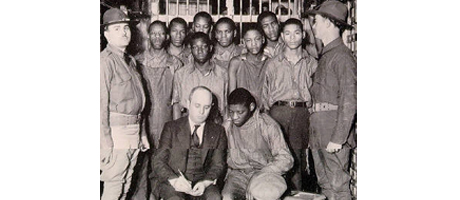By Rachel Muir
The trial name itself became synonymous with injustice.
In 1931, on the basis of flimsy and conflicting evidence, eight young black men were sentenced to death by an all-white jury for allegedly raping two white women on a train passing through Alabama. A ninth defendant was sentenced to life in prison.
The Scottsboro case — which took its name from the small Alabama town where the men were arrested, tried and convicted, all within the space of a few weeks — galvanized the attention of the nation and world. A series of retrials and appeals spanned the following seven years, resulting in more guilty verdicts in Alabama even after one of the accusers
recanted her testimony and reaching the U.S. Supreme Court twice. In the meantime, the “Scottsboro boys,” who ranged in age from 12 to 19 at the time of their arrest, spent years in prison.
In a new book, “Remembering Scottsboro: The Legacy of an Infamous Trial,” Professor and Chair of the Department of American Studies James Miller explores how the case has influenced American culture and perceptions of race, class, sexual politics and justice. “It was certainly one of the more egregious cases of racial injustice in 20th-century America, and it continues to function as a reference point, a barometer by which racial atrocities in the United States are sometimes measured,” says Dr. Miller, who became intrigued by the case when conducting research for a project on African-American cultural politics during the 1930s.
To write the book, Dr. Miller drew on archives from the Communist Party, which represented the men pro bono in many of the trials; the NAACP, which also provided legal assistance and publicity; contemporary newspapers and other media outlets; and works of art, including novels, plays and films. “The case attracted the attention of poets, playwrights, novelists and filmmakers during the 1930s and beyond,” says Dr. Miller. “We can see the influence of the case in Harper Lee’s ‘To Kill a Mockingbird,’ the 1936 film ‘Fury’ and, most recently, in Ellen Feldman’s ‘Scottsboro,’ a novel published earlier this year.”
Another source Dr. Miller tapped was the writings of one of the Scottsboro boys — Haywood Patterson, who spent 16 years in Alabama prisons. Patterson, who was illiterate at the time of his arrest, eventually penned hundreds of letters and a book about his experience.
“Haywood Patterson’s correspondence is fascinating,” says Dr. Miller. “It reveals the mind of a tough, shrewd character who became increasingly proficient in reading and writing during his prison years and who used his literacy as a key tool in his struggle for his freedom.” Patterson escaped from prison in 1948 and died from cancer four years later at the age of 39.
While the Scottsboro case was hardly the first instance of racial injustice in the nation, the widespread outcry it provoked and the mass campaign to free the Scottsboro boys anticipated key elements of the civil rights movement a few decades later. “The Scottsboro case, the strategies pursued by the supporters of the defendants and the debates it provoked were important antecedents to the modern civil rights movement,” says Dr. Miller, adding that the “mother” of the civil rights movement, Rosa Parks, and her husband played an active role in the movement for justice for the Scottsboro boys.
Dr. Miller, who spent last year in South Africa on a Fulbright Scholarship, says in writing the book he was surprised most by the intense emotions unleashed by the Scottsboro case and the breadth of its impact. “I was not fully aware of the depths of passion the case aroused, in the United States and abroad, particularly during the bleakest years of the Depression, or the ways in which it permeated so many aspects of American culture,” he says.


